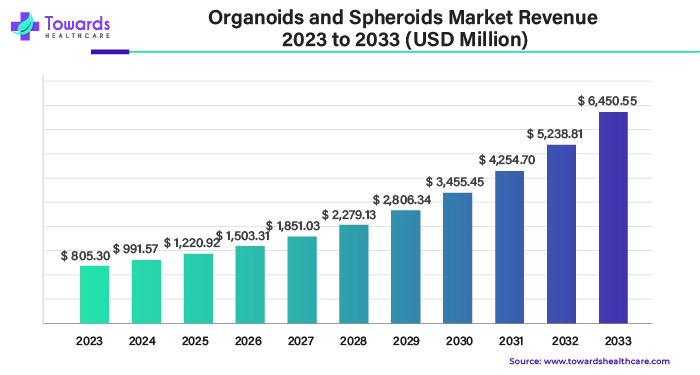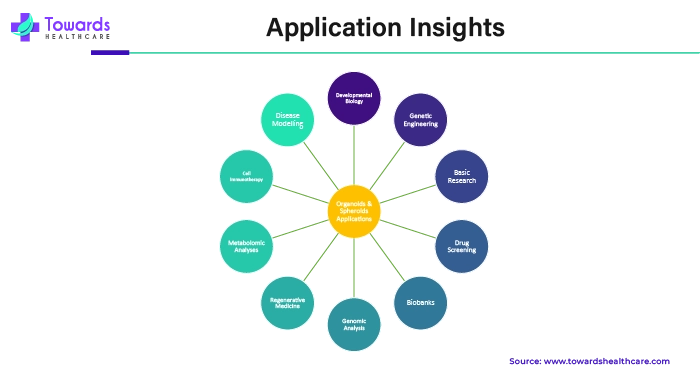March 2025

.webp)
Principal Consultant

Reviewed By
The organoids and spheroids market size reached US$ 805.3 million in 2023 and is expected to hit US$ 6,450.55 million by 2033. It is poised to grow at a CAGR of 23.13% from 2024 to 2033. Advances in genome editing technologies, automation, microfluidics, stem cell research, and microfluidics are driving substantial innovation in the sector.

The organoids and spheroids market encompasses the use of organoids and spheroids for various purposes, such as research and development, the study of different diseases, the development of personalized medicines, and so on. Spheroids, which can be seen in tumor tissue, embryoid bodies, hepatocytes, neurological tissue, or mammary glands, are basic clusters of widely distributed cells. Organoids are intricate collections of cells that are exclusive to a particular organ, such as the bladder, liver or stomach. Organoid models are being used more often to investigate and uncover the mechanism of the COVID-19 virus, which affects several intestinal cells, as a result of the recent coronavirus outbreak. Many scientists are already using these methods to evaluate and identify potential new drugs. Additionally, businesses involved in product development and launch are becoming more active in this field. The expansion of organoids and spheroids market has been driven by a wide range of applications.
| Company Name | Merch KGaA |
| Headquarters | Darmstadt, Germany |
| Research & Development Costs (2023) | Healthcare: € 1,657 million Life Science: € 396 million |
| Pipeline | This next generation of organoids based on chip technology is now being investigated by the firm, bringing colleagues in life science, healthcare, and electronics together to work on this innovative field, according to the company's annual report released in June 2024. |
| Company Name | InSphero |
| Headquarters | Schlieren, Switzerland |
| Pipeline | In May 2024, InSphero AG is happy to announce its exclusive commercialization agreement with Frankfurt, Germany-based Genome Biologics, as a substantial extension of its industry-leading portfolio. Through this collaboration, Genome Biologics' ground-breaking 3D Cardiac Organoid Platform will be exclusively licensed for worldwide commercialization to InSphero. The accurate, scalable, and disease-specific organoid models provided by this platform, which is at the forefront of heart disease research, are essential for the creation of cutting-edge treatments. |

The IARC projections underscore the increasing global cancer burden, the disproportionate impact on marginalized people, and the pressing need to address cancer disparities. They are based on the best data sources available in nations in 2022. An estimated 20 million new cases and 9.7 million deaths from cancer were predicted for 2022. 53.5 million people were thought to still be alive five years after being diagnosed with cancer. In their lifetime, 1 in 5 people will have cancer; 1 in 9 men and 1 in 12 women will pass away from the illness.
Understanding human development, the onset and course of disease, and tailored medical approaches—achievements that may not be achievable with animal models—has been made feasible by the creation of spheroid and organoid models. One cutting-edge technique is the use of 3D culture, especially when researching malignancies and finding possible anticancer medications for them. Comparing spheroids and organoids to other in vitro techniques for anticancer drug screening, it has been established that they are flexible in vitro preclinical models and instruments for translatable and dependable clinical outcomes.
For instance,
The development of tissue necrosis in the inner layer of both spheroids and organoids is the extent of their usefulness and maturation as pre-clinical models and in drug testing. Large-size spheroids and organoids are most affected by this due to their avascular nature and decreased diffusion of nutrients and oxygen. Necrosis occurs when there is insufficient perfusion flow and a dysfunctional vascular network in the inner layer of spheroids and organoids. There have been attempts to get around the problem, such as the use of affordable 3D bioprinting technology. It has been demonstrated that 3D bio-printed organoids can precisely deliver gene-drug connections and more accurately mimic complicated cell physiology with carriers of signaling molecules. Organ-on-a-chip systems have been able to provide nutrients more effectively because of the application of microfluidics technology.
Artificial intelligence (AI)- enabled organoids, which interface with AI, have the potential to completely transform the industry by providing new perspectives and approaches that help accelerate the creation and clinical use of organoids. AI-powered organoids combine AI with organoid development, accelerating new approaches. The AI interface makes multiscale picture processing, accurate preclinical evaluation, and organoid assembly possible. Acknowledging the difficulties in integrating AI with organisms can improve comprehension and streamline therapeutic implementations.
For instance,
Alongside AI, the development of a three-dimensional (3D) organoid culture system has been made possible by advances in our knowledge of organogenesis, stem cell niches, and disease models. In terms of comprehending the intricacies of human diseases, 3D organoid models represent a substantial technical advance that may be used for anything from the mechanistic exploration of disease causation to therapeutic intervention.
For instance,
By type, the spheroids segment dominated the organoids and spheroids market in 2023. The spheroid culture system presents itself as a compelling means of getting around the drawbacks of conventional monolayer culture. Spheroids have significant promise for a variety of applications, such as drug screening, regenerative medicine, and tumor research. One approach that shows promise for studying cancer cell tissue shape, immunological activation, and signaling cascades is the spheroid culture system. Tumor spheroids can decrease the unwanted side effects of medications that are still in development and offer detailed information about various illnesses.
By type, the organoids segment is expected to grow at the fastest rate during the forecast period. The ability to see stem cell morphogens, maintenance, and differentiation that mimic basic tissues in remarkable detail has been made feasible by the creation of human 3D organoid systems, which increases the possibility of studying human physiology and developmental stages. Patient-derived organoids are being utilized for gene repair, transplantation treatment, and customized and regenerative medicine, and they show significant potential for biomedical research and preclinical drug testing.

By application, the developmental biology segment held the largest share of the organoids and spheroids market in 2023. The field of developmental biology may benefit greatly from the use of organoids. The invention of organoids changed the field of developmental biology and made it possible to examine and alter human development and illness in a lab environment. Organoids are useful for studying the formation and function of various organs, as well as their developmental history. This can be used to assess the efficacy of novel therapies for congenital malformations as well as aid researchers in understanding the underlying causes of these diseases.
By application, the regenerative medicine segment is anticipated to grow at the fastest rate during the forecast period. Organogenesis and the transplantation of organoids are two advanced uses of organoids in regenerative medicine, namely in tissue engineering and stem cell treatment. There is great potential for the field of regenerative medicine to advance with the use of 3D organoids in stem cell treatment. Organoids provide a useful platform for studying the development of organs, modeling illness, and evaluating the efficacy of stem cell-based treatments. Researchers can examine the properties and interconnections of stem cell regeneration in the proper physiological setting by utilizing 3D organoids. This facilitates the development of innovative approaches and a better understanding of the mechanisms underlying tissue regeneration. In terms of modeling illnesses and bridging the gap between pre-clinical research and clinical application, the use of organoids offers the ability to solve several research hurdles.
By region, North America dominated the organoids and spheroids market in 2023. The American healthcare system, which is frequently ranked among the best in the world, provides quick access to a highly specialized network of doctors who are at the forefront of creating and using innovative, state-of-the-art treatments and drugs. The United States spends $3.8 trillion on healthcare in total. Every major city usually has a large number of highly competent doctors available to patients, giving them the freedom to select the facility, doctor, and level of expertise that best suits them. The American healthcare system has made large investments in pharmaceutical and medical research, which have produced ground-breaking findings and enhanced therapies across a range of specialties. The U.S. and Canada are the two main nations that support the expansion of the organoids and spheroids market in the area.
The U.S. is ideally positioned to lead the world in the rapidly developing field of customized medicine. Additionally, new regulations are being implemented in the U.S. to improve access to healthcare services and insurance. The patient group that has to be treated by clinicians is becoming more and more diversified as health insurance becomes more widely available. The U.S. has adopted telehealth as a novel strategy to address this need. From 0.3 million in 2010 to 27.6 million in 2022, more Americans will be using telehealth. Since the United States has made significant investments in research, it has become a leader in medical innovation, producing cutting-edge medications and medical technologies.
Additionally, there is a greater need for spheroids research due to the rising number of cancer cases in the United States; spheroids are typically employed to investigate malignant cells. The U.S. demographic investigations estimate that there will be 10 million cancer-related deaths and 20 million new instances of the disease each year.

By Type
By Method
By Source
By Application
By Region
March 2025
March 2025
March 2025
March 2025